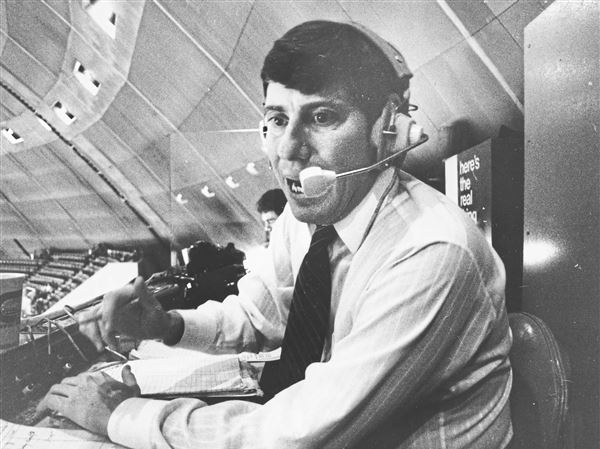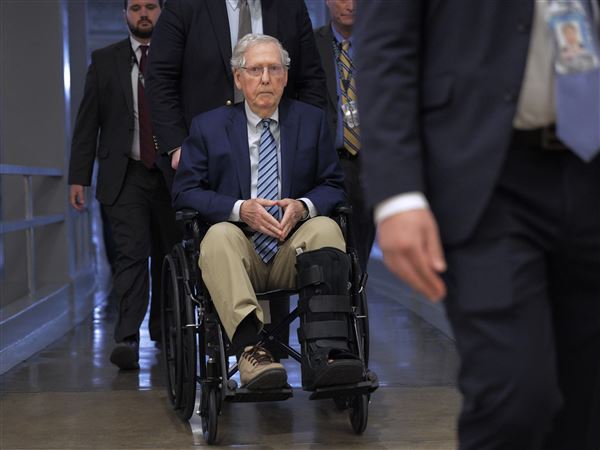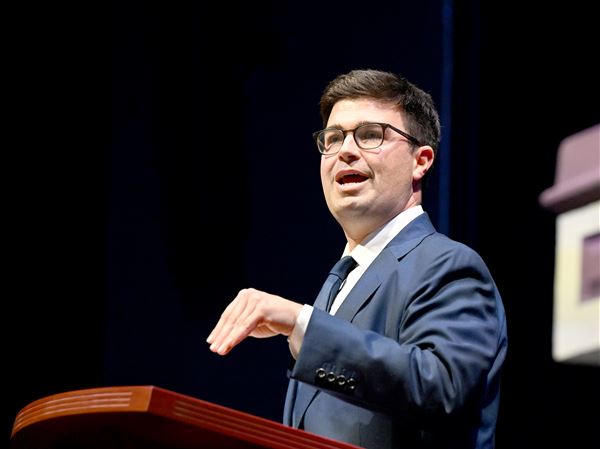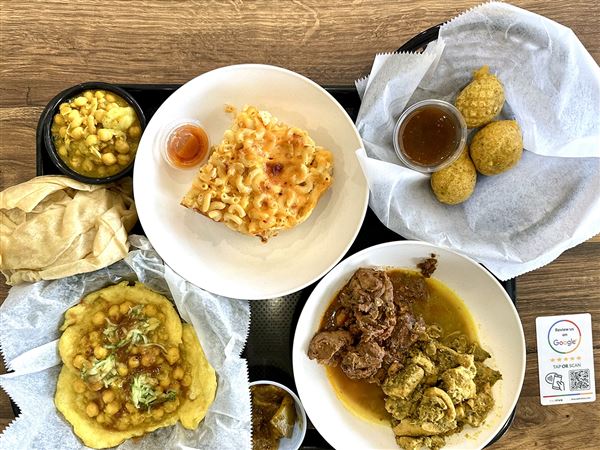Cemeteries take on an added dimension when the air turns crisp and the shadows begin to lengthen.
They are a great place to revisit some of the region's rich history. Several historic cemeteries in the region provide walking or vehicle tours with guides and are particularly beautiful when the leaves turn. You can see where the rich and famous reside for eternity and view how different ethnic and religious groups paid tribute to their loved ones.
In Homewood Cemetery in Squirrel Hill, for instance, you can find a Chinese incense pagoda, obelisks and even a pyramid.
In Allegheny Cemetery in Lawrenceville, you can pay tribute to the 80 victims, mostly teenage girls, who died in the Allegheny Arsenal explosion in 1862 and learn about a Gettysburg Civil War general from Greensburg or the founders of Mt. Lebanon.
Here is a walkthrough of four of the oldest cemeteries in the region, all of which were founded between 1840 and 1880. Before these public cemeteries existed, most residents of the Pittsburgh area were buried in church cemeteries or on a family's land. But a movement began in East Coast cities in the early 1800s for more park-like public cemeteries, and the trend soon caught on here.
The cemeteries became popular places for people to walk and even picnic. Today, the cemeteries often are enjoyed on a daily basis by joggers, photographers and nature lovers.
Homewood Cemetery, Squirrel Hill
"Fall is one of the most popular times of the year to visit the cemetery," according to Jennie Benford, a volunteer tour guide at Homewood Cemetery, which has huge oak, elm, maple, birch and other native varieties, providing a mosaic of color as the leaves turn.
"The trees are gorgeous, and the cemetery is a lawn-park design ... with large plots and sweeping sight lines."
Stretching from Point Breeze to Squirrel Hill, Homewood Cemetery was founded in 1878, about the time that Pittsburgh's coke, steel, glass and manufacturing prowess was emerging on the heels of the Industrial Revolution.
It is the resting place of some of the city's most prominent names from the Golden Age of industrialists in coal and steel.
Many of those industry giants and bankers lived in the East End during the late 1800s. They include Henry Clay Frick, whose house, Clayton, is nearby on Penn Avenue, and generations of the Mellons, who lived on Negley Avenue.
Situated on one of the highest hills of the cemetery is Section 14 -- the permanent residence of the Heinz, Benedum, Frick and Mellon families and other prominent citizens of the 19th and 20th centuries.
The monuments of Section 14 feature examples of 19th century architecture, ironwork, stained glass, sculpture and landscape design.
One tour that Ms. Benford gives of the cemetery is titled, "Taking it With You," a play on the saying, "You can't take it with you," which refers to the fact that material wealth stays behind when a person dies. The 90-minute tour, held every other Saturday, details the burial sites of some of the city's most wealthy industrialists and features biographical information as well as discussion of the monuments and landscape.
Another tour Ms. Benford gives is titled "Angels and Obelisks," which explores the symbolism found in American memorial art and landscapes. It includes a discussion of the many different classes, cultures and religions found among the 78,000 people who have made Homewood Cemetery their final home. This tour is given on alternate Saturdays with the "Taking it With You" tour.
The cemetery has 250 private mausoleums.
One of the most unusual memorials is a 40-foot Egyptian mausoleum in the shape of a pyramid that dominates Section 14, just a few paces from the family crypt of H.J. Heinz. But few know the identity of William Brown, the man who memorialized himself in a manner that resembled the memorials to the pharaohs of Egypt. Mr. Brown made his fortune in the barges that carried the coal that fueled the steel mills, but he had a love for Egyptian history.
A special Indo-Chinese section of the cemetery pays tribute to a once vibrant Chinatown along Pittsburgh's Second Avenue, Downtown, Ms. Benford said. In keeping with Chinese tradition, bodies were buried, but eventually that person's bones were sent back to China to be buried with ancestors. A pagoda was erected in the cemetery for offerings of incense and other items.
Allegheny Cemetery Lawrenceville
This is the city's oldest public cemetery, founded in 1844. Approximately 130,000 people are buried in the sprawling 300-acre park that stretches from Butler Street to Penn Avenue.
Today, Allegheny Cemetery has more than 15 miles of roads and 100 acres remain for future development.
The original Gothic guardhouse, arched gates and chapel-turned-office along Butler Street showcase the prominent architecture in the late 1800s.
Pittsburgh composer Stephen Foster's gravesite is the top attraction in the cemetery. Foster was born on Penn Avenue in Lawrenceville in 1826 and spent most of his life in the city. He died in New York City after a fall at the age of 37.
"It is a global attraction," Nancy Craigo, assistant to the cemetery president, said of his grave. "We get people from French Canada, Japan and California who come to see his grave."
To commemorate Foster's life and music, the cemetery holds an annual summer festival called "Doo-Dah Days," a reference to the lyrics in "Camptown Races," one of his popular minstrel songs.
This year, the festival featured individuals in period costumes, Civil War re-enactors, a U.S. Colored Troops Drum Corps, trolley tours and horse-and-wagon rides.
One of the most poignant markers in the cemetery is the Allegheny Arsenal memorial, which pays tribute to the 80 victims of the ammunitions plant that exploded in 1862 at a nearby site.
"It was very tragic," Ms. Craigo said. "Most of the victims were young teenage girls. The youngest was an 11-year-old Irish immigrant. Their small delicate hands were perfect for stuffing the cartridges with gun powder."
Other famous Pittsburghers buried in the cemetery include Judge Thomas Mellon and American Civil War General James Negley, actress Lillian Russell and "Rosey" Rosewell, once the voice of the Pittsburgh Pirates.
A military section of the cemetery is final home to 10,000 veterans.
Allegheny Cemetery is too large for walking tours, but groups of 10 or more can take a vehicle tour with guide Roger Galbraith, superintendent of the cemetery who has worked there for 40 years. Individuals also can obtain a map at the office and take a self-guided tour.
Because the cemetery has abundant wildlife, ponds and fountains, it is also a popular place with photographers, garden clubs and Scouts, Ms. Craigo said, as well as historical groups and organizations such as Venture Outdoors, which promotes exercise.
Mt. Lebanon Cemetery
Established in 1874, Mt. Lebanon Cemetery is along Washington Road, next to the police and fire station.
Its 95 acres hold about 22,000 graves and two century-old trees.
It was the first nondenominational cemetery in the South Hills, said Gwyn Cready, a board member of the Mt. Lebanon Historical Society who leads walking tours of the cemetery. A 90-minute tour is scheduled for Saturday.
U.S. Rep. James Fulton, who died in 1971, is one of the better-known people buried there. He was elected as a Republican to Congress in 1944 and served until his death.
Victor Cianca, the Pittsburgh policeman who directed traffic with white gloves and was featured in the movie "Flashdance," also is buried there. He first gained notoriety with his expressive body and hand moves in an appearance on Candid Camera in 1964.
Ten Revolutionary War soldiers are buried in the cemetery as are Mt. Lebanon's first doctor, Ruggles Sylvester; its first postmaster, Caleb Milholland; and its first minister, the Rev. Joseph Kerr. Some of the founders of Mt. Lebanon are buried there as well.
Casper Carlisle, a Civil War Congressional Medal of Honor recipient, is one of the best-known soldiers buried there. He served as a private and was awarded the medal for his bravery on the second day of the Battle of Gettysburg on July 2, 1863.
The cemetery is open 24 hours a day, she said, and is a popular place for walkers and joggers.
Across Scott Road from the Mt. Lebanon Cemetery is St. Clair Cemetery, which was founded in 1805 and has graves dating to the French and Indian War, according to Ms. Cready.
St. Clair Cemetery, Hempfield
Another cemetery called St. Clair Cemetery is in Hempfield. It was founded in 1856 by a Civil War general, said site manager Gary Rutter.
It is named for a major general who fought alongside George Washington in the Revolutionary War.
"Arthur St. Clair was president of the Continental Congress that preceded George Washington and other founding fathers who wrote the Constitution and formed our first government," Mr. Rutter said.
St. Clair lived in the Ligonier Valley and was once the largest landowner in Western Pennsylvania.
The original cemetery was at the current site of St. Clair Park in Greensburg, and that's where St. Clair's grave remains. But most of the other graves were moved in 1892 to a new cemetery near Westmoreland Mall in Hempfield.
The new St. Clair cemetery followed the pastoral movement, in which cemeteries became more park-like and were located in more rustic environments. The cemetery has 144 acres, and 20,000 people are buried there.
Richard Coulter, a Civil War general, is buried in the cemetery, and four or five generals from the battles of Antietam and Gettysburg also are buried there, he said. Coulter led a regiment on the first day of fighting at Gettysburg. After the war, he went into business in Greensburg with George Huff, who was in the coal business and was a legislator and banker.
One of the distinctive mausoleums in the cemetery belongs to the Huff family, and the area known as Hufftown in South Greensburg was named for him.
"Most of the big granite monuments here were for the coal company industrialists from the early 1900s, from all the coal patches in the area," Mr. Rutter said. "We have the poorer cousins to the industrialists of Pittsburgh."
U.S. Sen. Edgar Cowan, who represented Pennsylvania during the Civil War, is also buried there.
Mr. Rutter said the Westmoreland Historical Society held a special Memorial Day celebration at the cemetery this year, with Civil War re-enactors and a Lincoln impersonator.
The cemetery began as a Protestant cemetery but soon was opened to Catholics as well. One-third of the burials now are Catholic, he said.
Cemetery details:
Allegheny Cemetery -- self-guided maps, guided vehicle tours for groups of 10 or more; 412-363-8639 or www.alleghenycemetery.com.
Homewood Cemetery -- Final walking tours of the season will be held Nov. 2 and 9; 412-421-1822 or www.thehomewoodcemetery.com.
Mt. Lebanon Cemetery -- Tour at 1 p.m. Saturday, sponsored by the Historical Society of Mt. Lebanon. Registration required: cready@gmail.com or 412-418-9348. To reach the cemetery: 412-531-2007.
St. Clair Cemetery -- Hempfield; 724-837-2620.
Debra Duncan, freelance writer: suburbanliving@post-gazette.com.
First Published: October 24, 2013, 8:57 a.m.















